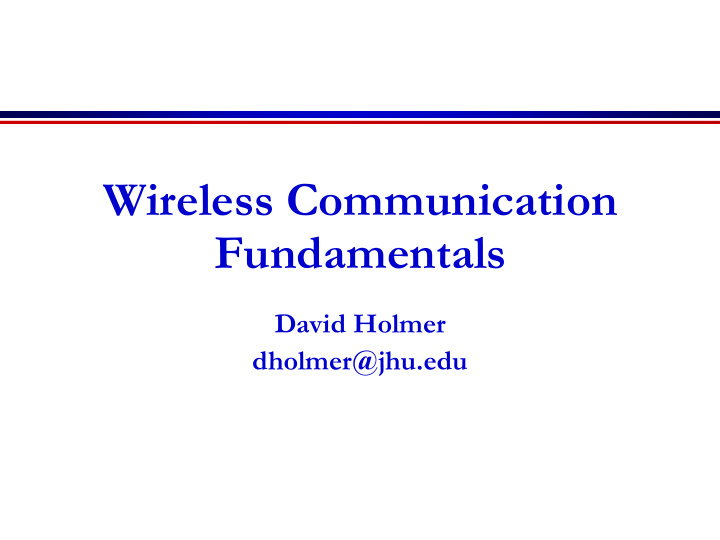



Wireless Communication Fundamentals David Holmer dholmer@jhu.edu
Physical Properties of Wireless � Makes wireless network different from wired networks � Should be taken into account by all layers
Wireless = Waves � Electromagnetic radiation � Emitted by sinusoidal current running through a wire (transmitting antenna) � Creates propagating sinusoidal magnetic and electric fields according to Maxwell’s equations: � Fields induce current in receiving antenna
Wave Propagation Example electric field propagation direction magnetic field
Frequency & Public Use Bands c � Propagating sinusoidal wave with f = some frequency/wavelength λ � C (speed of light) = 3x10 8 m/s Name 900 Mhz 2.4 Ghz 5 Ghz Range 902 - 928 2.4 - 2.4835 5.15 - 5.35 Bandwidth 26 Mhz 83.5 Mhz 200 Mhz Wavelength .33m / 13.1” .125m / 4.9” .06 m / 2.4”
Free-space Path-loss � Power of wireless transmission reduces with square of distance (due to surface area increase of sphere) � Reduction also depends on wavelength � Long wave length (low frequency) has less loss � Short wave length (high frequency) has more loss 2 π D 4 = P L λ
Other Path-loss Exponents � Path-Loss Exponent Depends on environment: Free space 2 Urban area cellular 2.7 to 3.5 Shadowed urban cell 3 to 5 In building LOS 1.6 to 1.8 Obstructed in building 4 to 6 Obstructed in factories 2 to 3
Multi-path Propagation � Electromagnetic waves bounce off of conductive (metal) objects � Reflected waves received along with direct wave
Multi-Path Effect � Multi-path components are delayed depending on path length (delay spread) � Phase shift causes frequency dependent constructive / destructive interference Amplitude Amplitude Time Frequency
Modulation � Modulation allows the wave to carry information by adjusting its properties in a time varying way � Amplitude � Frequency � Phase � Digital modulation using discrete “steps” so that information can be recovered despite noise/interference � 8VSB - US HDTV � BFSK - Mote Sensor Networks � QPSK - 2 Mbps 802.11 & CMDA(IS-95)
Multi-transmitter Interference � Similar to multi-path � Two transmitting stations will constructively/destructively interfere with each other at the receiver � Receiver will “hear” the sum of the two signals, which usually means garbage
Recommend
More recommend